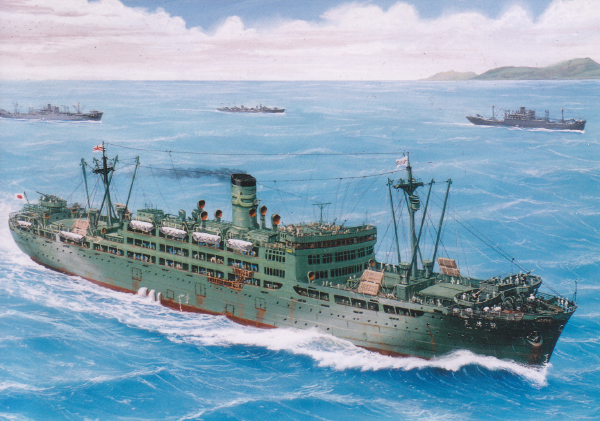| Oryoku Maru |
Oryoku Maru

| Operator | Osaka Shosen |
| Classification | Passenger-cargo ship |
| Gross tonnage | 7,362 tons |
| Speed | 18.6 knots |
| Departure point | Manila |
| Departure date | 13 December 1944 |
| Destination | Japan |
| No. of POWs | 1,619 (about 1,100 officers & 500 enlisted men) |
| Location of disaster | Off Olongapo, Luzon Island |
| Date of disaster | 15 December 1944 |
| POW casualties | 286 |
| POW survivors | 1,333 |
| Painting | Courtesy of Mr. Kihachiro Ueda |
When Oryoku Maru left the pier of Manila harbor on the evening of 13 December 1944 with the Japanese soldiers, women and children, crews and passengers of other shipwrecked vessels (a total of about 3,200 people), the ashes of 728 war dead, and about 1,600 POWs aboard, the invasion of Luzon Island by the US Forces was imminent. The ship moved to an anchorage outside the harbor, and spent a night there.
This POWs' embarkation was observed by many friendly Filipinos, and this information must have been relayed by radio to MacArthur's Headquarters, and to Nimitz's Headquarters in Pearl Harbor, and then to Adm. Halsey, the Commander- in-Chief of the Third Fleet, of which the Task Force 38 was a part. However, it would probably have not changed their orders to attack the Japanese ships.
After embarkation, the POWs were distributed to three holds; about 600 in the first, 200 in the second, and 800 in the third hold, respectively. The living conditions in the holds were equal to or worse than those of the worst of the hell ships - in the holds it was pitch-dark without lights and no ventilation. With the heat, thirst, and lack of oxygen, men became mad, and some died from suffocation or being crushed. On the following morning with first light, about 50 copses were brought out of the holds.
At about 03:00 on 14 December, the convoy weighed anchor, and got underway, headed for Takao, being escorted by the destroyer Momo and sub-chaser No. 60.
Five hours after they got underway, at about 08:00, carrier-based planes of the TF 38's Hornet (CV12) attacked Oryoku Maru. She sustained six rockets and one 250 kg bomb hits, and a fire broke out. As she gradually took water and listed heavily, at around 03:00 on 15 December, they began landing women and children from about 200 meters off Olongapo Point to the shore, and almost all of them got ashore by 06:30. Before 08:00, when they started landing those remaining aboard and the POWs, the planes flew over again, and repeated bombing and strafing runs fiercely. Around 11:00, a letter "P" was marked with white blankets on the bridge, and "W" was drawn on the boat deck, but of no avail. Many POWs desperately waved and shouted themselves hoarse. Finally, one of the planes rocked its wings for acknowledgment, and stopped attacking. Other planes also changed to attack targets on land. About 16:00, all completed landing. From 16 to 18 December, about 1,300 POWs were placed in a cement-paved tennis court within the Navy facilities.
On 19 December, several trucks arrived with guards. On the trucks were medical supplies, provisions and clothing, and the men were instructed to stay in Olongapo until further notice. Some POWs died, and were buried at a local cemetery.
By orders, on 20 December, the POWs moved to South San Fernando (northwest of Manila) by truck, and they were placed in a movie theater and a jail to be on stand by. During this time, 15 sickest men were singled out for hospitalization in Manila; however, they were executed in the suburbs of the city.
Shortly after 10:00 on 24 December, a little less than 1,300 POWs were loaded on about 15 boxcars, and left South San Fernando station for North San Fernando (La Union). On their way over, whenever air raid warning was issued, the train stopped, and evacuated. About 04:00 on 25 December, they arrived at North San Fernando, and were placed in a nearby school house. Then, the POWs were instructed by Akatsuki Butai (Large shipping group headquarters) to gather near the pier and wait. They were to embark on Brazil Maru (5,860 tons).
About 03:00 on the morning of 27 December, the POWs were instructed by Akatsuki Butai to hurriedly embark on Enoura Maru, in lieu of Brazil Maru, and begin boarding at 04:00. They followed the instruction, and began embarking immediately. However, at 06:30, when about 700 POWs had completed boarding, by order of a high-ranking officer of Akatsuki Butai, in order to expedite the boarding of the POWs, about 600 POWs still not yet boarded should be split into two groups of about 300 each, so that 1,040 men should be on Enoura Maru and 240 on Brazil Maru, respectively. As soon as the boarding of the POWs was completed, the two tankers, which had been eagerly waiting for the completion of boarding of the POWs, immediately got underway to evade possible air raids. The three ships were escorted by the destroyer Kuretake and three sub-chasers, and steamed to the north. They evaded the attacks of US submarines, and arrived at the anchorage off Takao on the evening of 31st. Kuretake was sunk by the USS Razorback. During the voyage, 20 POWs died aboard Enoura Maru, and 5 aboard Brazil Maru, respectively.
After arriving at Takao, continued the sufferings of the POWs who had survived in the sinking of Oryoku Maru. Under the imminent situations that the Allied Forces invasion of Taiwan might take place any day, the POWs could not receive any support of any kind from anyone. On 6 January 1945, all POWs were moved to Enoura Maru. However, on 8 January, 34 Dutch and 2 British POWs who had survived in the sinking of other ships were transferred to a Camp in Taiwan.